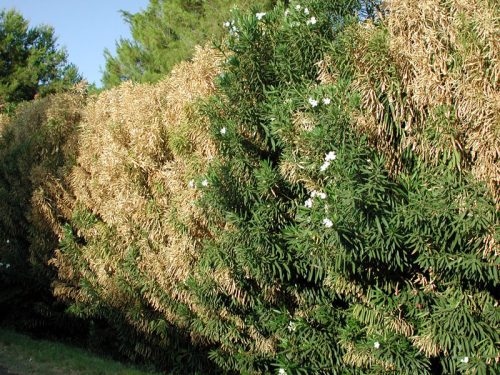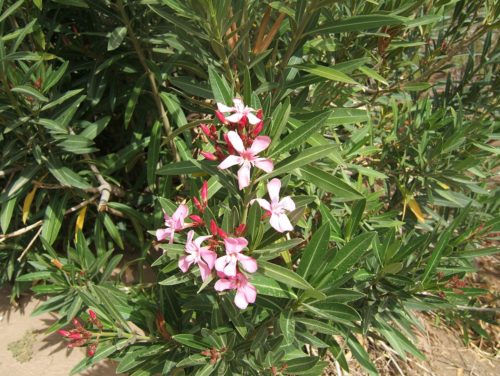Oleander is a bushy shrub that can grow between two and six feet tall.
You are viewing the mobile-adapted version of the page.
The one for tablets, laptop and desktop also provides general information, such as origin, toxicity and cultivation.
Oleander – (Nerium oleander) is a bushy shrub that can grow between two and six feet tall. Oleanders are evergreen and as a rule (there are exceptions) not hardy. Oleander belongs to the periwinkle family (Apocynaceae) and is native to countries around the Mediterranean Sea.
Oleanders are often planted in containers. They bloom in the summer.
In the open ground, Oleander likes a sheltered spot in full sun. Preferably plant a hardy variety in the open ground or provide the Oleander with a solid cover against frost. Oleanders like a calcareous and nutrient-rich soil with a neutral pH (7). They do not feel at home in acidic soil and on peat or peaty soil. Fertilize Oleanders in the spring.
In spring, prune dead and frost-damaged branches to just above the ground. Overgrown branches can be pruned back to about half their length in September after flowering.
The soil in which the plant stands should be slightly moist. Prevent Oleanders from drying out during dry periods, water regularly.
Bugs
Red, yellow or brown spots develop on the leaves; the leaves eventually die. The plant becomes deformed and lags in growth: oleander scale (Aspodiotus nerii).
Fungi & diseases
Leaves start writhing and watery streaks and thickening appear on stems, leaf tips wither: Pseudomonas ssp.

Leaf dries, turns brown, leaf edges scorch and leaves and branches die: Oleander leaf scorch (Xy
Other
Leaves hang limp, yellowing. In severe cases, leaf tips die: too little water causes the plant to dry out.
Drought symptoms also occur with excess water, where the roots are in the water. Because the roots are submerged, a lack of oxygen causes the roots to suffocate or rot.

